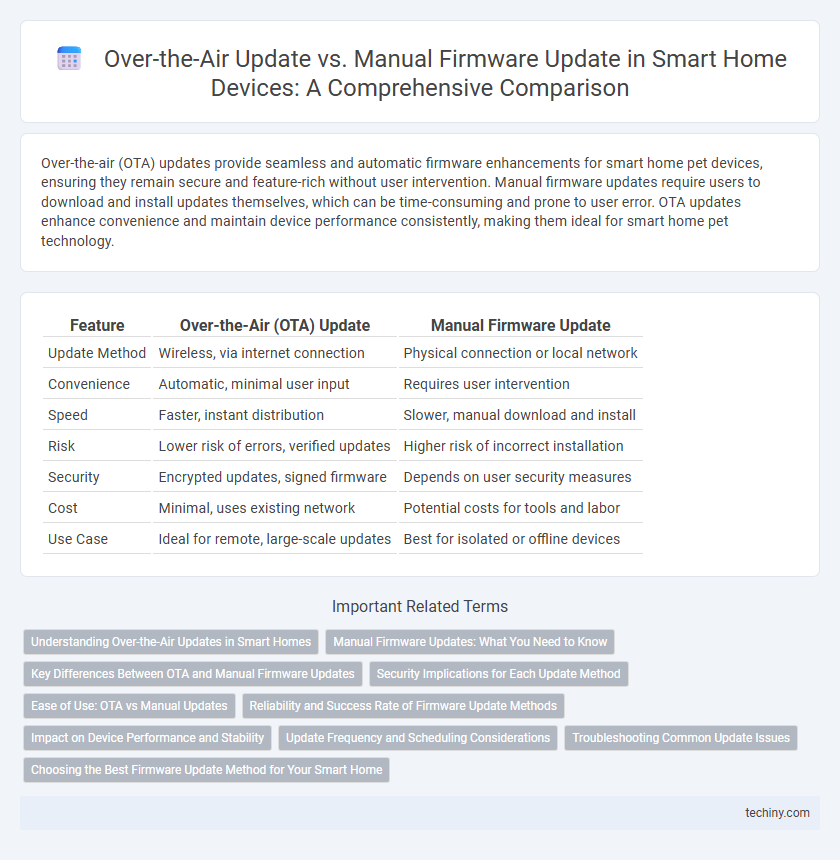Over-the-air (OTA) updates provide seamless and automatic firmware enhancements for smart home pet devices, ensuring they remain secure and feature-rich without user intervention. Manual firmware updates require users to download and install updates themselves, which can be time-consuming and prone to user error. OTA updates enhance convenience and maintain device performance consistently, making them ideal for smart home pet technology.
Table of Comparison
| Feature | Over-the-Air (OTA) Update | Manual Firmware Update |
|---|---|---|
| Update Method | Wireless, via internet connection | Physical connection or local network |
| Convenience | Automatic, minimal user input | Requires user intervention |
| Speed | Faster, instant distribution | Slower, manual download and install |
| Risk | Lower risk of errors, verified updates | Higher risk of incorrect installation |
| Security | Encrypted updates, signed firmware | Depends on user security measures |
| Cost | Minimal, uses existing network | Potential costs for tools and labor |
| Use Case | Ideal for remote, large-scale updates | Best for isolated or offline devices |
Understanding Over-the-Air Updates in Smart Homes
Over-the-Air (OTA) updates in smart homes enable seamless, remote firmware upgrades without user intervention, ensuring devices stay secure and feature-rich. Unlike manual firmware updates requiring physical access and user action, OTA updates minimize downtime and reduce maintenance costs. This automated process leverages wireless connectivity to deliver timely patches, enhancing the performance and reliability of connected smart home devices.
Manual Firmware Updates: What You Need to Know
Manual firmware updates require users to download the update file from the manufacturer's website and install it via a USB drive or dedicated app, ensuring control over the timing and installation process. This method is essential for devices lacking stable internet connectivity or when automatic updates risk causing disruptions during critical usage. Firmware stability and compatibility must be verified beforehand to prevent potential bricking or security vulnerabilities in smart home devices.
Key Differences Between OTA and Manual Firmware Updates
Over-the-air (OTA) updates enable wireless, remote firmware upgrades for smart home devices, ensuring timely enhancements without user intervention. Manual firmware updates require physical access or local network connection to install updates, often involving more time and technical effort. OTA updates increase efficiency and security by simplifying deployment, while manual updates provide more control but can delay critical patches.
Security Implications for Each Update Method
Over-the-Air (OTA) updates enhance smart home security by enabling timely, automated delivery of critical patches directly from the manufacturer, reducing vulnerability windows. Manual firmware updates require user intervention, which can delay security fixes and increase the risk of exploitation during the update gap. OTA updates also incorporate encrypted transfer protocols and authentication mechanisms to prevent unauthorized firmware installation, whereas manual updates are more susceptible to human error and tampering.
Ease of Use: OTA vs Manual Updates
Over-the-Air (OTA) updates simplify the firmware upgrade process by enabling remote, automatic installation without requiring user intervention or technical expertise. Manual firmware updates often demand physical device access, complex setup procedures, and pose risks of user error, reducing overall convenience. OTA updates enhance user experience by providing seamless, timely improvements that maintain smart home device functionality effortlessly.
Reliability and Success Rate of Firmware Update Methods
Over-the-air (OTA) updates for smart home devices offer higher reliability and success rates compared to manual firmware updates by enabling seamless, remote installation with automated error detection and rollback features. Manual updates carry a greater risk of failure due to user error, incomplete installation, or power interruptions during the process. Studies show OTA updates achieve success rates exceeding 95%, while manual updates often fall below 80%, highlighting the critical importance of automated update mechanisms for maintaining device security and functionality.
Impact on Device Performance and Stability
Over-the-Air (OTA) updates enhance device performance and stability by enabling automated, timely software patches and feature improvements without user intervention, reducing downtime and security risks. Manual firmware updates rely on user initiation, which may delay critical fixes and lead to inconsistent device performance and potential vulnerabilities. OTA updates ensure continuous optimization, whereas manual updates risk device instability due to irregular application and user errors.
Update Frequency and Scheduling Considerations
Over-the-air (OTA) updates enable frequent and automated firmware improvements without user intervention, ensuring smart home devices stay secure and up-to-date with the latest features. Manual firmware updates require user initiation, which can lead to inconsistent update schedules and increased risk of outdated software. Scheduling considerations favor OTA updates due to their ability to perform updates during low-usage periods, minimizing disruption to smart home functionality.
Troubleshooting Common Update Issues
Over-the-Air (OTA) updates streamline troubleshooting by automatically resolving compatibility and security issues without user intervention, reducing downtime and errors commonly seen in manual firmware updates. Manual firmware updates often require precise user actions, such as correct file selection and stable connections, which can lead to update failures or device bricking. Implementing OTA updates enhances device reliability and simplifies recovery by providing seamless rollback options and real-time update status monitoring.
Choosing the Best Firmware Update Method for Your Smart Home
Over-the-Air (OTA) updates streamline smart home device management by enabling automatic firmware installation, reducing downtime and enhancing security with timely patches. Manual firmware updates require user intervention, offering greater control but risking delayed implementation and potential compatibility issues. Selecting the best firmware update method hinges on balancing convenience, security needs, and technical expertise within your smart home ecosystem.
Over-the-Air Update vs Manual Firmware Update Infographic

 techiny.com
techiny.com